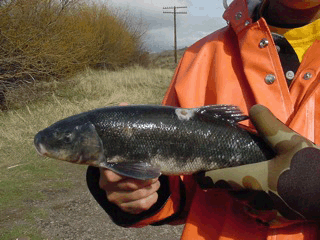Shortnose Sucker
-
Scientific NameChasmistes brevirostris
-
NativeYes
-
Identification
 Shortnose sucker. Photo by Stewart Reid, Western Fishes, Ashland, OR.
Shortnose sucker. Photo by Stewart Reid, Western Fishes, Ashland, OR.- Cylinder-like body, up to 50 cm FL, over 45 cm FL uncommon
- Large head, short nose; may have hump
- Terminal mouth: thin lips, lower lip with deep medial notch, papillae discreet (0-5 rows)
- Juveniles: separated lower lip, stumpy caudal peduncle, long anal fin reaches tail origin when depressed
- Dark dorsal coloration, white to yellow underside
- Breeding adults may have reddish scales along the lateral line
- Fin rays: dorsal 10-13, anal 7
- Lateral line scales: 67-92, 12-20 scales above line, 9-13 scales below line
-
Life History
Shortnose Suckers favor large shallow lakes with abundant aquatic vegetation and cool, well-oxygenated water. Temperatures in favorable waters might not exceed 25°C, and oxygen levels would remain above a level of 4-9 mg/L. Favored conditions are rare today, though Shortnose Suckers have shown adaptability. They may survive temperatures as high as 31-33°C and dissolved oxygen levels as low as 1 mg/L . Most native lakes are now eutrophic due to excess nutrients. Typically juvenile suckers are found along the edge of lakes among aquatic vegetation where dissolved oxygen levels are high, though they occasionally live in streams. They probably feed primarily on insects. Adult Shortnose Suckers may also inhabit streams, but generally live in lakes where they feed mostly on zooplankton. A sucker’s growth is most rapid in the first 5 years of what can be up to a 33 year life span. Growth generally occurs at a rate of roughly 1 cm per year and females grow more rapidly and reach greater total lengths than males. Shortnose Suckers achieve sexual maturity at age 5 or 6. Spawning usually occurs in tributary streams around May. Fish begin migrating upstream in February-April when snowmelt elevates stream levels. Spawning takes place in groups above beds of gravel or cobble substrate. One female produces an average of 38,000 eggs, and each females may be attended to by several males who wait to fertilize her eggs. After several weeks of incubation, the eggs hatch and release larvae between late April and early June. The larvae quickly drift and swim downstream with peak emigration occurring at night. When the larvae reach a lake they quickly take on a benthic lifestyle.
-
Links to Other ResearchN / A
